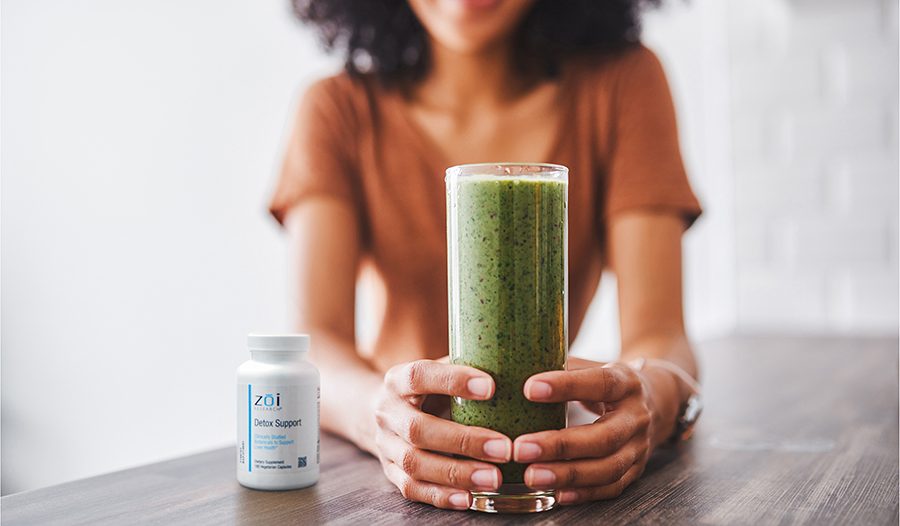7 Steps to Naturally Detox Your Body

The term, “detox,” can convey several meanings, such as describing the removal of addictive drugs from the body. However, in preventative medicine, it usually refers to metabolic detoxification. Metabolic detoxification denotes the essential and constant process of removing chemicals or waste from the body. Our liver, kidneys, skin, and lymphatic system remain hard at work, detoxifying our bodies from the plethora of toxins we encounter.
We stay healthier if our detoxification system functions well and our chemical burden remains low. Convenient living choices in a modernized world have drastically increased the amount of toxic burden we daily face. Luckily, many effective lifestyle measures, foods, and supplements can aid the body to detoxify more efficiently and rapidly.
4 Primary Reasons to Support Our Detoxification Process
1. Increased Exposure to Environmental Chemicals
Though living beings have had exposure to a low level of toxins in the environment for most of history, the amount of chemical exposure around us has grown exponentially and causes concern for our health. The more modern your lifestyle, the more likely you will contact a wide array of toxins, including pesticides, herbicides, volatile organic compounds, preservatives, flame retardants (in clothes and on furniture), plastics such as phthalates and bisphenol A (BPA), heavy metals (such as mercury), and many others.
Despite the amazing ability of a pregnant mother to provide nourishment for a growing baby, she cannot fully protect her baby from the many chemical exposures we face today. A study of pregnant mothers showed that over 280 chemicals from the environment travel via the placenta to the fetus. This demonstrates the significance of our toxic burden even before we place our feet on earth’s soil and the importance of detoxing regularly.1
2. History Supports Rituals to Detoxify
If you look at most ancient cultures, they had regular rituals that included periodic detoxification practices such as Native American sweat lodges and the drinking of herbal remedies. “Medicine men” often treated illness with various concoctions that made subjects eliminate or sweat. These ancient rituals helped to increase blood flow, lymph flow, digestion, and urination to clear waste to heal.
3. Link to Premature Aging
Science directly correlates metabolic toxin load with increased oxidative stress. Increased oxidative stress predisposes us to premature aging, inflammation, and chronic disease — the more chemicals in our system, the more likely we will advance in aging and acquire a chronic illness.
4. Link to Hormone Imbalance in Children
Many “modern-age” toxins — abundant in our water, food, and food packaging — prove to disrupt endocrine function (fertility, thyroid function). Common chemicals such as plastics and pesticides represent endocrine-disrupting chemicals or EDCs — causing an increased prevalence of hormonal imbalances in our youth such as precocious puberty and abnormal development of genitalia.2
Primary Organs for Detox
Your liver, along with your kidneys, skin, and lymphatics signify primary organs involved in whole-body detoxification. Detoxification involves a chain of events. A toxic molecule that enters the body almost always diverts to the liver for processing, the mother organ for metabolic detox. Once a molecule has been processed in the liver, the liver returns it into circulation to be removed via the kidneys.
Simultaneously, our skin — the largest organ of detox — rids an average of two pounds of toxins a day from the blood through perspiration. This presents a fascinating fact considering how many shy away from any form of sweating instead of embracing the process for optimal health.
The often-overlooked lymphatic system has the primary function of removing waste from the body, delivering nutrients to the cells, and housing a large part of our immune system. It comprises an extensive system of channels and nodes running through the entire body collecting cell debris.
As you can see, our complex detox system should be respected and supported.
7 Steps to Lower Toxins in Your Body
1. Don’t Take Drugs Regularly Or Drink Alcohol Excessively
Sedatives, stimulants, nicotine, alcohol, and many over-the-counter pain medications (like acetaminophen and ibuprofen) metabolize through the liver or kidney — and when overused — will slow down the system we rely on for protection.
2. Drink More Water
Getting adequate water throughout the day helps blood flow, lymphatic flow, and our ability to sweat. Water with lemon and a pinch of sea salt or added electrolytes can be even more detoxing. Lemon and salt help our cells absorb and utilize the water we need.
3. Eat Organic Products From Humanely Raised Animals
Animal products from animals raised in an artificial environment expose us to synthetic hormones and antibiotics they receive and the pesticides they eat. All of these can be found in our blood after eating these meats and dairy products.
4. Eat Organic Produce
Seventy-five percent of food sold in stores contain glyphosate residue. Crops remain purposefully genetically modified to be resistant to this pesticide. While this pesticide conveniently kills insects, it results in genetically engineered, pesticide-ridden food. Glyphosate has been banned in many countries — but not yet in the USA. Glyphosate exposure has been linked to an increased risk of cancer, infertility, as well as neuromuscular and autoimmune diseases.
5. Detoxify With Food
Consider eating cruciferous veggies daily — the ones that release a very distinct sulfur‐like smell in the kitchen when cooking — broccoli, cauliflower, kale, brussel sprouts, arugula, bok choy, cabbage, and onions. Each of these, when digested, contains secondary compounds that upregulate liver enzymes to improve metabolism.3
Some people may think they have trouble eating these foods because of the odor or bitterness. But, they remain vastly different depending on how you season and cook them. Once these brilliantly-colored plants release their sulfur smell in the very early stages of cooking, they become sweeter tasting. Adding grass‐fed butter, herbs, and spices make them delectable.
For example, have you tried brussel sprouts diced, bathed in avocado oil, and slowly roasted in the oven with bacon, salt, and sweet balsamic glaze? Consider this decadent, bittersweet party on the tongue.
Other foods proven to aid metabolic detox include beets, garlic, ginger, berries, organic soy, and spices such as cayenne and turmeric.4 Ginger root has the added benefit of lowering inflammatory response and aiding digestion and cayenne the added benefit of stimulating circulation.
6. Exercise and Sweat
Movement remains one of the most powerful things we can do for our health. Not only does increasing your heart rate help your blood carry oxygen to your brain, but it also enables the transport of white blood cells that fight infection and clears the burden of toxicity in your body.
If you work out hard enough to sweat, you get the additional skin detoxification. Exercise can help you achieve mental and emotional balance, lower your risk of Alzheimer's disease, decrease the accumulation of toxins in your body, and help your skin shine.
Sweating primarily brings toxins out of your body through your skin. We should induce a good sweat daily. Good options include a sauna, steam, or hot bath. Make sure you stay healthy, hydrated, and “signed off” by a physician before using saunas or steam rooms as intense heat can stress the body when not well.
7. Add Detox Supplements
Many herbs and other compounds in nature can help boost detoxification tenfold and remain safe to use with medical guidance.
“Detox” supplements work by supporting one or more of the six biochemical phases of detoxification: acetylation, amino acid conjugation, glucuronidation, glutathione conjugation, methylation, and sulfation. A few key supplements that support these phases include:
- Milk thistle: aids the liver by keeping toxins from attaching to liver cells
- Dandelion root: enhances the liver’s detox ability — and as a natural diuretic — helps the kidneys filter water
- Glutathione, or NAC (N Acetyl Cysteine): helps with a process called conjugation, which can remove toxins such as heavy metals and lower oxidative stress
You can find milk thistle and dandelion in capsule or tea form and glutathione or NAC almost always in capsule form to contain its boiled egg-like odor. Many people take these detox aids at the advice of their providers for one to six weeks with a detailed detox food plan.
These regimens can often be repeated throughout the year. Caution should be taken to have a medical provider guide you as rapid detox measures can be harmful or bring unnecessary side effects (body aches, headaches, and fatigue).
In general, adopting clean eating habits, sweating, and moving regularly helps to remove toxins from our body. Detoxification can be effectively enhanced with a more intense detox regimen (under medical supervision) including detox supplements, a cleansing food plan, and a strategic movement routine.
References:
- A Benchmark Investigation of Industrial Chemicals, Pollutants, and Pesticides in Umbilical Cord Blood. Environmental Working Group, July 14, 2005
- Fudvoye J, Lopez-Rodriguez D, Franssen D, Parent AS. Endocrine disrupters and possible contribution to pubertal changes. Best Pract Res Clin Endocrinol Metab. 2019;33(3):101300. doi:10.1016/j.beem.2019.101300
- Nho CW, Jeffery E. The synergistic upregulation of phase II detoxification enzymes by glucosinolate breakdown products in cruciferous vegetables. Toxicol Appl Pharmacol. 2001;174(2):146-152. doi:10.1006/taap.2001.9207
- Hodges RE, Minich DM. Modulation of Metabolic Detoxification Pathways Using Foods and Food-Derived Components: A Scientific Review with Clinical Application. J Nutr Metab. 2015;2015:760689. doi:10.1155/2015/760689
DISCLAIMER:This Wellness Hub does not intend to provide diagnosis...














































































 Table of Contents
Table of Contents















